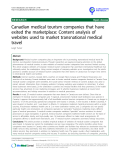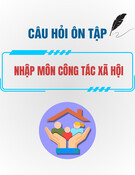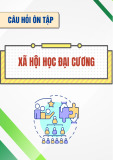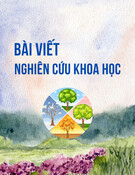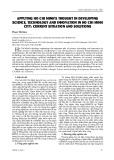
Tuyển tập Hội nghị Khoa học thường niên năm 2024. ISBN: 978-604-82-8175-5
553
REPRESENTATIONS OF CULTURAL INTOLERANCE IN
VIETNAMESE FACEBOOK SOCIAL GROUPS
Lam Thi Lan Huong
Thuyloi University, email: lamhuong@tlu.edu.vn
1. INTRODUCTION
Humanity has benefited more from
developments in online social networks and
Internet technologies. However, the
unfavorable aspect of this development has
made cultural intolerance more prevalent and
potent threats on a global scale. Cultural
intolerance consists of any idea, action,
policy, or social structure that views people
unfairly because of their membership in a
group (Baldwin et al., 2014). Cultural
intolerance is represented in a variety of types
such as cognition, attribution, stereotypes,
prejudice, behaviour, and policy and social
structure. Cultural intolerance happens not
only after a shocking incident or trigger event
but also in normal situations in cyberspace.
Vietnam is currently one of the top ten
countries with the most active Facebook users
in the world with about 66.2 million users,
ranked number seven (Quang Huy, 2023). It
can be seen that Facebook is no longer simply
a means of conveying information and
contacting each other but also an effective tool
in spreading cultural products, preserving
traditional, creative and popular cultural
values, and transforming new cultural values.
The benefits and positive impacts that
Facebook bring are undeniable. However,
along with good values, many negative sides
and problems from social groups in Facebook
appear. Among them, what is alarming is the
deterioration of morality, deviations from
standards in online behavior culture and even
taking advantage of social networks
intentionally or unintentionally to express
intolerance towards others in cyberspace.
2. METHODOLOGY
This paper looked at the representations of
cultural intolerance in Vietnam social
networks from three perspectives:
stereotypes, prejudice, and discrimination as
specified in Baldwin et al. (2014). Content
analysis was used to examine the author’s
Facebook page, which includes a variety of
social groups. To ensure the objectivity of the
results, each day the author examined one
post of a social group page that appeared
randomly in her new feeds. Due to time
limits, this content analysis was done within
only a week.
3. RESULTS
The content analysis of random social
groups in Facebook in a limited time of one
week revealed a frequent representation of
stereotypes, prejudice, and discrimination in
social groups.
First of all, Facebook users tend to have a
lot of stereotypes towards others in
cyberspace. Stereotypes are the simplistic
views a person has about others because
he/she believes they share the traits of a
particular group (Lustig & Koester, 2010).
People often generalise about others and
exaggerate their traits without taking into
account their unique qualities. The
stereotyped group are usually considered as
not nice, wrong, inferior or unimportant. In
Facebook social networks, stereotypes often
originate from: regions of the world (e.g.
Arabs or Africans), regions within countries
(e.g., Northern/Southern Vietnamese), cities









